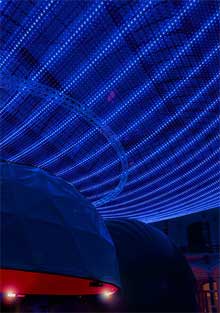 I finally got to visit From Spark to Pixel. Art + New Media, which presents developments in contemporary art involving the large-scale use of digital and interactive media. The exhibition is running at Martin Gropius Bau in Berlin until 14 January 2008.
I finally got to visit From Spark to Pixel. Art + New Media, which presents developments in contemporary art involving the large-scale use of digital and interactive media. The exhibition is running at Martin Gropius Bau in Berlin until 14 January 2008.
Image on the left: Erwin Redl, Berlin Flow, 2007. Photo: Lepkowski Studios, Berlin
What a great show! I want more of these. I want more traditional museums taking up the challenge to exhibit new media art works and demonstrating that although it certainly isn’t a piece of cake, setting up a new media art show doesn’t have to be such a challenge after all. I want more media art where families have a good time, where even the art snob will admit that this is indeed art and not just some geekery, where the security people smile at you and say that you can touch (though not everything and being allowed to touch doesn´t imply that hell won´t break loose if you take your photo camera out of your bag which wouldn’t drive me wild if at least their press office could provide us with a decent collection of images showing details, works seen from several sides, etc.). Their book shop had even stacked up an amazing collection of essays about media art (i bought half of them, and left what i couldn´t carry). But big thumb down to you guys for publishing a catalog in german only.
Spark to Pixel is pure heavy machinery with dark rooms, experiments straight from the physics class, references to the pre-history of cinema, illusion tricks and glowing bulbs.
One of the most striking pieces is the artificial blue sky that Erwin Redl has created specifically for the Martin-Gropius-Bau. But then i might be a bit biased when it comes to Redl because i have a soft spot for his work. Never met the guy but his installation was the first installation of “new media art” i remember having seen. It was Matrix IV which was part of a show called Massless Medium: Explorations in Sensory Immersion, back in 2001 in Brooklyn.
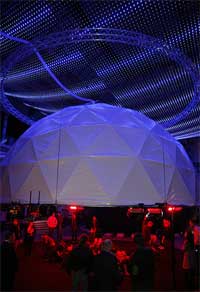
Anyway, Flow Berlin is a virtual ceiling made up of 30,000 blue LEDs mounted on cables. The individual strings of LEDs are switched on and off in sequence and form an enormous wave pattern.
You can experience the work from the atrium below, and from there it looks like an electro sky but if you go upstairs and see it from the balcony it appears as a living light wave.
Image on the right: Ulf Langheinrich: Hemisphere, 2006–2007. Photo: Jirka Jansch
When you’re on the ground floor, you can also have a good look at the way Flow Berlin dialogs with Ulf Langheinrich‘s Hemisphere, 2006-2007. Hemisphere is an artificial space created by 5 high definition beamers projecting onto a suspended cupola. The installation plunges the visitor into an immersive environment that, despite the seductive apparatus of presentation, comes close to a charged nothingness. What is perceivable is a fine murmuring and shimmering that essentially rests on calculations of fractal structures and particle systems. It is an aesthetic plasma that is constantly restructured and changing.
Hemisphere seemed to have on visitors an effect similar to the one created by Ólafur ElÃasson‘s Weather Project at Tate Modern a couple of years ago. People sitting underneath the cupola, their head up or they lying, under the spell of the constantly changing granular virtual world, they are very quiet, as if they were under the effect of some luminous drug.
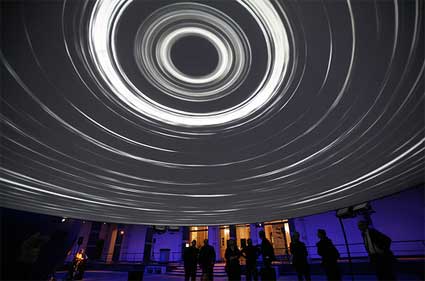 Ulf Langheinrich: Hemisphere, 2006–2007. Photo: Jirka Jansch
Ulf Langheinrich: Hemisphere, 2006–2007. Photo: Jirka Jansch
Curator Richard Castelli has articulated the exhibition around four key concepts -fire, electricity, light and pixel- which each draw attention to the way contemporary artists engage with energy. Starting with fire, the first form of energy to be mastered by man, the exhibition follows human evolution through the stages of electricity, light and the pixel. I’ll just follow my own whim and will to do my best not to whinge profusely because the information and the pictures offered in the press kit are so scarce that i won’t be able to talk (let alone show) much about some of the pieces…
Aaaanyway, let’s stoically keep on blogging and mention another startling piece: Brad Hwang’s latest installation Time May Change Me / I Can’t Change Time. It looks like a super long sledge with an electrostatic generator and two huge revolving discs. You can hop on, sit down and start rowing, your movements will be turned into electricity.
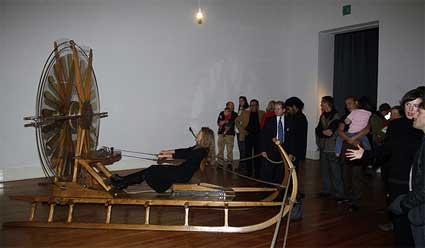 Brad Hwang, Time May Change Me / I Can’t Change Time, 2007. Photo: Jirka Jansch
Brad Hwang, Time May Change Me / I Can’t Change Time, 2007. Photo: Jirka Jansch
You can’t see it from the picture provided in the crap press kit (there goes my stoicism) but the effect is enchanting: the room is dark and the sparkles and little noises created while rowing reminded me that something that we usually take for granted, electricity, is actually quite magical and fascinating.
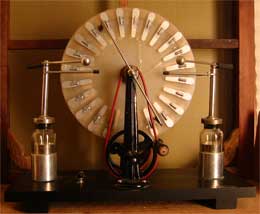 The work is based on the Wimshurst Influence machine (image on the right), an electrostatic machine for generating high voltages. Developed between 1880 and 1883 by James Wimshurst, the electrical generator features two large contra-rotating discs mounted in a vertical plane, two crossed bars across them, and a spark gap formed by two metal spheres.
The work is based on the Wimshurst Influence machine (image on the right), an electrostatic machine for generating high voltages. Developed between 1880 and 1883 by James Wimshurst, the electrical generator features two large contra-rotating discs mounted in a vertical plane, two crossed bars across them, and a spark gap formed by two metal spheres.
With this installation Hwang is trying to change the parameters of physical space and to combine visible and invisible phenomena with his homemade constructions and to expand the metaphorical aspects of the Wimshurst machine to become “a time machine�.
Images courtesy of Martin Gropius Bau.
